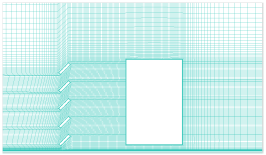
A remarkable research activity about wind barriers for ground traffic protection optimization is running at the University of Ljubljana.
In strict cooperation with the University of Rome “Tor Vergata”, we have supported this study.
RBF Morph allowed the parametrization of adjustable deflectors angles enabling a complex HPC optimization process.
We see this result as an excellent evolution of a research cooperation between the Italian and Slovenian Universities after joint efforts at PRACE Autumn School.
Abstract
by Marijo Telenta ( telenta@lecad.si)
Faculty of Mechanical Engineering, University in Ljubljana
A numerical workflow (ANSYS Fluent and RBF Morph), validated using wind tunnel testing (Telenta, et al., 2013) and (Telenta, et al., 2014), has been defined for the simulation of wind barriers used for ground traffic protection.
The protection is achieved using five adjustable deflectors.

Aerodynamic optimization simulation process needs to be accurate, extensive and automated.
In order to insure accuracy, 23 million hexahedral grid elements are generated for the numerical simulation. In addition, design space is represented by 53 design points in order the optimization to be extensive.
Finally, Ansys Workbench is used as automation platform.
The goal is to present an aerodynamic simulation methodology that can be implemented for wind barrier optimization with accuracy and extended design space in automated manner.
HPC impact figures:
- – time to read solution 7s
- – time to morph 249s,
- – time required to run one design point was about 3 hours for 2250 iterations on 204 cores.


Works cited
Telenta, M., Duhovnik, J., Kosel, F. & Šajn, V., 2013. Wake interaction of a rectangular prism behind a geometrically accurate porous barrier.Journal TECHNICAL GAZETTE, pp. 877-882.
Telenta, M., Duhovnik, J., Kosel, F. & Šajn, V., 2014. Numerical and experimental study of the flow through a geometrically accurate porous wind barrier model. Journal of Wind Engineering and Industrial Aerodynamics, pp. 99-108.



